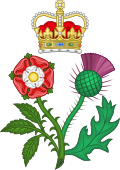Jacobitism
| Jacobitism | |
|---|---|
| Scottish Gaelic:Na Seumasaich Irish:Seacaibíteachas, Na Séamusaigh | |
 James Francis Edward Stuart,Jacobite claimant between 1701 and 1766 | |
| Leaders |
|
| Military leaders | |
| Dates of operation | 1688–1780s |
| Active regions | British Isles |
| Ideology |
|
| Battles and wars | |
Jacobitism[c]was a political ideology advocating the restoration of theCatholicHouse of Stuartto theBritish throne.WhenJames II of Englandchose exile after the November 1688Glorious Revolution,theParliament of Englandruled he had "abandoned" the English throne, which was given to hisProtestantdaughterMary II of England,and her husbandWilliam III.[1]On the same basis, in April theScottish Conventionawarded Mary and William the throne of Scotland.[2]
The Revolution created the principle of a contract between monarch and people, which if violated meant the monarch could be removed. A key tenet of Jacobitism was that kings were appointed by God, making the post-1688 regime illegitimate. However, it also functioned as an outlet for popular discontent and thus was a complex mix of ideas, many opposed by the Stuarts themselves. Conflict betweenPrince Charlesand Scottish Jacobites over theActs of Union 1707anddivine rightseriously undermined the1745 rising.
Jacobitism was strongest in Ireland, the WesternScottish Highlands,Perthshire,andAberdeenshire.[3]Pockets of support were also present inWales,Northern England,theWest MidlandsandSouth West England,all areas stronglyRoyalistduring theWars of the Three Kingdoms.In addition, the Stuarts received intermittent backing from countries likeFrance,usually dependent on their own strategic objectives.
In addition to the 1689–1691Williamite War in IrelandandJacobite rising of 1689inScotland,there were serious revolts in1715,1719and 1745, French invasion attempts in1708and1744,and numerous unsuccessful plots. While the 1745 Rising briefly seemed to threaten theHanoverianmonarchy, its defeat in 1746 ended Jacobitism as a serious political movement.
Political background
[edit]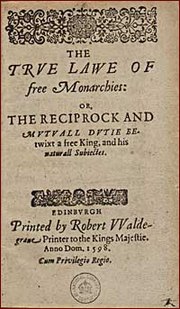
Jacobite ideology originated withJames VI and I,who in 1603 became the first monarch to rule all three kingdoms ofEngland,ScotlandandIreland.Its basis wasdivine right,which claimed his authority came from God, and the crown's descent by indefeasible hereditary right: James and his supporters emphasised his right to the throne by blood to forestall controversy over his appointment byElizabeth Ias her successor.[4]Personal rule by the monarch eliminated the need for Parliaments, and required political and religious union, concepts widely unpopular in all three kingdoms.[5]
Divine right also clashed with Catholic allegiance to thePopeand with Protestantnonconformists,since both argued there was an authority above the king.[6]The 17th-century belief that 'true religion' and 'good government' were one and the same meant disputes in one area fed into the other;Millenarianismand belief in the imminence of theSecond Comingmeant manyProtestantsviewed such issues as urgent and real.[7]
As the first step towards union, James began standardising religious practices between the churches ofEngland,ScotlandandIreland.After his death in 1625, this was continued by his sonCharles I,who lacked his political sensitivity; by the late 1630s, institutingPersonal Rulein 1629, enforcingLaudianreforms on the Church of England, and ruling withoutParliamentled to a political crisis.[8]Similar measures in Scotland caused the 1639–1640Bishops' Wars,and installation of aCovenantergovernment.[9]
Organised by a small group of Catholic nobility, the October 1641Irish Rebellionwas the cumulative effect of land confiscation, loss of political control, anti-Catholic measures and economic decline. The Rebellion was intended as a bloodless coup, but its leaders quickly lost control, leading to atrocities on both sides.[10]In May, a Covenanter army landed inUlsterto support Scots settlers. Although Charles and Parliament both supported raising an army to suppress the Rebellion, neither trusted the other with its control; these tensions ultimately led to the outbreak of theFirst English Civil Warin August 1642.[11]
In 1642, theCatholic Confederacyrepresenting the Irish insurgents proclaimed allegiance to Charles, but the Stuarts were an unreliable ally, since concessions in Ireland cost them Protestant support in all three kingdoms. In addition, theAdventurers' Act,approved by Charles in March 1642, funded suppression of the revolt by confiscating land from Irish Catholics, much of it owned by members of the Confederacy.[12]The result was a three-way contest between the Confederacy, Royalist forces under the ProtestantDuke of Ormond,and a Covenanter-led army in Ulster. The latter were increasingly at odds with the English government; after Charles' execution in January 1649, Ormond combined these factions to resist the 1649-to-1652Cromwellian conquest of Ireland.[13]
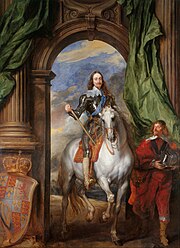
Charles IIrepudiated his alliance with the Confederacy, in return for Scottish support in theThird English Civil War,and Ormond went into exile in 1650. Defeat in 1652 led to themass confiscationof Catholic and Royalist land, and its re-distribution among English Parliamentary soldiers and Protestant settlers.[14]The three kingdoms were combined into theCommonwealth of England,regaining their separate status when the monarchy was restored in 1660.[15]
Charles's reign was dominated by the expansionist policies ofLouis XIVof France, seen as a threat to Protestant Europe. When his brother and heirJamesannounced his conversion to Catholicism in 1677, an attempt was made tobar him from the English throne.[16]Nevertheless, he became king in February 1685 with widespread support in England and Scotland; a Catholic monarch was preferable to excluding the 'natural heir', and rebellions by Protestant dissidents quickly suppressed. It was also viewed as temporary; James was 52, his second marriage was childless after 11 years, and his Protestant daughterMarywas heir.[17]
His religion made James popular among Irish Catholics, whose position had not improved under his brother. By 1685, Catholic land ownership had fallen to 22%, from 90% in 1600, not least through Catholic landlords converting to the Anglican Church. After 1673, a series of proclamations deprived Catholic gentry of theright to bear armsor hold public office.[18]The CatholicRichard Talbot, 1st Earl of Tyrconnell,was appointedLord Deputy of Irelandin 1687, and began building a Catholic establishment that could survive James. Fearing a short reign, Tyrconnell moved at a speed that destabilised all three kingdoms.[19]
James dismissed the English and Scottish Parliaments when they refused to approve his measures ofreligious tolerance,which he enforced using theRoyal Prerogative.Doing so threatened to re-open disputes over religion, reward those who rebelled in 1685 and undermine his own supporters. It also ignored the impact of the 1685Edict of Fontainebleau,which revoked tolerance forFrench Protestantsand created an estimated 400,000 refugees, 40,000 of whom settled in London.[20]Two events turned discontent into rebellion, the first being the birth ofJames's sonon 10 June 1688, which created the prospect of a Catholic dynasty. The second was James' prosecution of theSeven Bishops,which seemed to go beyond tolerance for Catholicism and actively attack the Church of England; their acquittal on 30 June caused widespread rejoicing throughout England and Scotland, and destroyed James's political authority.[21]
In 1685, many feared civil war if James were bypassed; by 1688, even theEarl of Sunderland,his chief minister, felt only his removal could prevent it. Sunderland secretly co-ordinated anInvitation to William,assuring Mary and her husband, and James's nephew,William of Orangeof English support for armed intervention. William landed inBrixhamon 5 November with 14,000 men; as he advanced, James's army deserted and he went into exile on 23 December.[22]In February 1689, theEnglish Parliamentappointed William and Mary joint monarchs of England, while theScotsfollowed suit in March.[23]
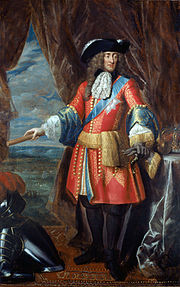
Most of Ireland was still controlled by Tyrconnell, where James landed on 12 March 1689 with 6,000 French troops. The 1689-to-1691Williamite War in Irelandhighlighted two recurring trends; for James and his successors, the main prize was England, with Ireland and Scotland secondary to that, while the primary French objective was to absorb British resources, not necessarily restore the Stuarts.[24]Elections in May 1689 produced the firstIrish Parliamentwith a Catholic majority since 1613. It repealed the Cromwellian land seizures, confiscated land from Williamites, and proclaimed Ireland a 'distinct kingdom from England', measures annulled after defeat in 1691.[25]
AJacobite risingin Scotland achieved some initial success but was ultimately suppressed. Several days after the Irish Jacobites were defeated atThe Battle of the Boynein July 1690, victory atBeachy Headgave the French temporary control of theEnglish Channel.James returned to France to urge an immediate invasion of England, but the Anglo-Dutch fleet soon regained maritime supremacy, and the opportunity was lost.[26]
The Irish Jacobites and their French allies were finally defeated at thebattle of Aughrimin 1691, and theTreaty of Limerickended the war in Ireland; future risings on behalf of the exiled Stuarts were confined to England and Scotland. TheAct of Settlement 1701barred Catholics from the English throne, and whenAnnebecame the last Stuart monarch in 1702, her heir was her Protestant cousinSophia of Hanover,not her Catholic half-brother James. Ireland retained a separate Parliament until 1800, but the1707 Unioncombined England and Scotland into theKingdom of Great Britain.Anne viewed this as the unified Protestant kingdom which her predecessors had failed to achieve.[27]
The exiled Stuarts continued to agitate for a return to power, based on the support they retained within the three kingdoms of England, Scotland and Ireland.[28][29][30]Doing so required external help, most consistently supplied by France, while Spain backed the1719 Rising.While talks were also held at different times withSweden,Prussia,andRussia,these never produced concrete results. Although the Stuarts were useful as a lever, their foreign backers generally had little interest in their restoration.[31]
Ideology
[edit]HistorianFrank McLynnidentifies seven primary drivers in Jacobitism, noting that while the movement contained "sincere men [..] who aimed solely to restore the Stuarts", it "provided a source of legitimacy for political dissent of all kinds".[32]Establishing the ideology of active participants is complicated by the fact that "by and large, those who wrote most did not act, and those who acted wrote little, if anything."[33]As a result, historians have taken different views on its primary driving force. These include being an aristocratic rejection of an increasinglyUnitary state,feudal opposition to capitalism, or Scots and Irish nationalism.[34]
Jacobitism drew on elements of apolitical theologyshared byNon-juring,Tory elements within the Church of England, and members of theScottish Episcopal Church.[35]These were thedivine right of kings,their accountability to God, not man or Parliament; secondly, that monarchy was a divine institution; thirdly,legitimism,the crown's descent by indefeasible dynastic right, which could not be overturned or annulled; and lastly the scriptural injunction of passive obedience and non-resistance, even towards monarchs of which the individual subject might disapprove.[36][37]

Jacobite propagandists argued such divinely sanctioned authority was the main moral safeguard of society, while its absence led topartystrife. They claimed the 1688 Revolution had enabledpolitical corruptionand allowed selfish opportunists, such as Whigs, religious dissenters, and foreigners, to take control of the government and oppress the common people.[38]
However, views on the 'correct' balance of rights and duties between monarch and subject varied, and Jacobites attempted to distinguish between 'arbitrary' and 'absolute' power. Non-juringChurch of IrelandclergymanCharles Lesliewas perhaps the most extreme divine right theorist, but even he argued the monarch was bound by "his oath to God, as well as his promise to his people" and "the laws of justice and honour".[39]Jacobite pamphlets often suggested domestic issues were divine punishment on the British for rejecting their rightful king, although post 1710 this was blamed specifically on theWhigs.[40]
These views were not held by all Jacobites,[41]while many Whigs argued the post 1688 succession was also "divinely ordained".[36][42]After the 1701 Act of Settlement, Jacobite propagandists deemphasised the purely legitimist elements in their writing and by 1745, active promotion of hereditary and indefeasible right was restricted largely to a few Scots Episcopalians such as LordsPitsligoandBalmerino.[43]
Instead they began to focus on populist themes such as opposition to a standing army,political corruption,and social injustice.[44]By the 1750s, Charles himself promised triennial parliaments, disbanding the army and legal guarantees onfreedom of the press.[45]Such tactics broadened their appeal but also carried risks, since they could always be coopted by a government prepared to offer similar concessions.[46]The ongoing Stuart focus on England and regaining a united British throne led to tensions with their broader-based supporters in 1745, when the primary goal of most Scots Jacobites was ending the 1707 Union. This meant that following victory atPrestonpansin September, they preferred to negotiate, rather than invade England as Charles wanted.[47]
More generally, Jacobite theorists reflected a broader conservative current inEnlightenmentthought, appealing to those attracted to a monarchist solution to perceived modern decadence.[48]Populist songs and tracts presented the Stuarts as capable of correcting a wide range of ills and restoring social harmony, as well as contrasting Dutch and Hanoverian "foreigners" with a man who even in exile continued to consume English beef and beer.[49]While particularly calculated to appeal to Tories, the wide range of themes adopted by Jacobite pamphleteers and agents periodically drew in disaffected Whigs and former radicals. Such "Whig-Jacobites" were highly valued by the exiled court, although many viewed James II as a potentially weak king from whom it would be easy to extract concessions in the event of a restoration.[50]
Jacobite supporters in the three kingdoms
[edit]Ireland
[edit]The role of Jacobitism in Irish political history is debated; some argue that it was a broad-based popular movement and the main driver of Irish Catholic nationalism between 1688 and 1795.[51]Others see it as part of "a pan-British movement, rooted in confessional and dynastic loyalties", very different from 19th-century Irish nationalism.[52]Historian Vincent Morely describes Irish Jacobitism as a distinctive ideology within the broader movement that "emphasised theMilesianancestry of the Stuarts, their loyalty to Catholicism, and Ireland's status as a kingdom with a Crown of its own. "[53]In the first half of the 18th century, Jacobitism was "the primary allegiance of politically conscious Catholics".[54]

Irish Catholic support for James was predicated on his religion and assumed willingness to deliver their demands. In 1685, IrishbardDáibhí Ó Bruadaircelebrated his accession as ensuring the revived supremacy of both theCatholic Church in Irelandand theIrish language.Tyrconnell's expansion of the army by the creation of Catholic regiments was welcomed by Diarmuid Mac Carthaigh, as enabling the native Irish 'Tadhg' to be armed and to assert his dominance over "John" the English Protestant.[55]Conversely, most Irish Protestants viewed his policies as designed to "utterly ruin the Protestant interest and the English interest in Ireland".[56]This restricted Protestant Jacobitism to "doctrinaire clergymen, disgruntled Tory landowners and Catholic converts", who opposed Catholicism but still viewed James' removal as unlawful.[57]A few Church of Ireland ministers refused to swear allegiance to the new regime and becameNon-Jurors,the most famous being propagandistCharles Leslie.[58]
Since regaining England was his primary objective, James viewed Ireland as a strategic dead-end butLouis XIVof France argued it was the best place to launch aregime changewar, since the administration was controlled by Tyrconnell and his cause was popular among the majority Catholic population.[59]James landed atKinsalein March 1689 and in May called the firstParliament of Irelandsince 1666, primarily seeking taxes to fund the war effort. Tyrconnell ensured a predominantly Catholic electorate and candidates by issuing newboroughcharters, admitting Catholics into city corporations, and removing "disloyal members".[60]Since elections were not held in many northern areas, theIrish House of Commonswas 70 members short, and 224 out of 230MPswere Catholic.[61]
Known to 19th-century Irish historians as the "Patriot Parliament",it opened by proclaiming James as the rightful king and condemning the" treasonous subjects "who had ousted him. There were some divisions among Irish Jacobites on the issue of returning all Catholic lands confiscatedin 1652after theCromwellian conquest of Ireland.The majority of the Irish House of Commons wanted the1652 Cromwellian Act of Settlementrepealed in its entirety, with ownership returned to that prevailing in 1641. This was opposed by a minority within the Catholic elite who had benefited from the1662 Act of Settlement,a group that included James himself, Tyrconnell and other members of theIrish House of Lords.Instead, they suggested those dispossessed in the 1650s should be restored to half their estates and paid compensation for the remainder.[62]However, with the Commons overwhelmingly in favour of complete restoration, Tyrconnell persuaded the Lords to approve the bill.[63]
More serious were differences between Parliament and James, who resisted any measures that might "dissatisfy his Protestant subjects" in England and Scotland.[63]These conflicted with the demands of the Irish Parliament, which in addition to land restoration included toleration for Catholicism and Irish autonomy.[64]A French diplomat observed James had 'a heart too English to do anything that might vex the English.' He therefore resisted measures that might "dissatisfy his Protestant subjects" in England and Scotland, complaining "he was fallen into the hands of a people who would ram many hard things down his throat".[63]When it became clear Parliament would only vote war taxes if he met their minimum demands, James reluctantly gave his assent to Tyrconnell's land bill and passed aBill of attainder,confiscating estates from 2,000 mostly Protestant "rebels".[65]Although he also approved Parliament's resolution that Ireland was a "distinct kingdom" and laws passed in England did not apply there, he refused to abolishPoynings' Law,which required Irish legislation to be approved by the English Parliament.[66]
Despite his own Catholicism, James viewed the Protestant Church of Ireland as an important part of his support base; he insisted on retaining its legal pre-eminence, although agreeing landowners would only have to paytithesto clergy of their own religion.[65]However, the price for these concessions was to largely remove the Anglican element from Irish Jacobitism, which thereafter became almost entirely a Catholic ideology. After 1690, Irish Jacobites were also split between Tyrconnell's 'Peace party' who continued to seek a negotiated solution, and a 'War party' led byPatrick Sarsfieldwho favoured fighting on to the end.[67]
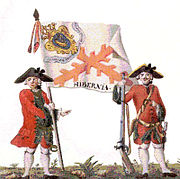
James left Ireland after defeat atthe Boynein 1690, telling his supporters to "shift for themselves".[68]This led some to depict him as (Irish:"Séamus an chaca","James of the shit" ), who had deserted his loyal followers.[69]However, Gaelic scholarBreandán Ó Buachallaclaims his reputation subsequently recovered as "the rightful king...destined to return' and upper-class Irish Jacobite writers likeCharles O'Kellyand Nicholas Plunkett blamed "corrupt English and Scottish advisors" for his apparent desertion.[70]
After 1691, measures passed by the 1689 Parliament were annulled,penal lawscriminalized the practice of Catholicism and barred Catholics from public life, while the Act of Attainder was used to justify further land confiscations. 12,000 Jacobite soldiers went into exile in the diaspora known as theFlight of the Wild Geese,the majority of whom were later absorbed into theFrench Royal Army'sIrish Brigade.About 1,000 men were recruited for the French and Spanish armies annually, many with a "tangible commitment to the Stuart cause".[71]Elements of the French Irish Brigade participated in the Scottish Jacobite rising of 1745.
Irish-language poets, especially inMunster,continued to champion the cause after James' death; in 1715, Eoin O Callanain described his son PrinceJames Francis Edward Stuartas "taoiseach na nGaoidheal"or" chieftain of the Gaels ".[72]As in England, throughout the 1720s, Prince James' birthday on 10 June was marked by celebrations in Dublin, and towns likeKilkennyandGalway.These were often accompanied by rioting, suggested as proof of popular pro-Jacobite sympathies.[73]Others argue riots were common in 18th-century urban areas and see them as a "series of ritualised clashes".[74]
Combined with Jacobite rhetoric and symbolism in the many works ofAislingpoetry composed in theIrish languageand widespread popular support forrapparees,or Jacobiteguerrillas,likeÉamonn an Chnoic,John Hurley,andGalloping Hogan,provides, some historians now claim, proof of popular support for a Stuart restoration.[75]Others, however, argue that it is hard to discern "how far rhetorical Jacobitism reflected support for the Stuarts, as opposed to discontent with the status quo".[76]Nevertheless, fears of resurgent Catholic Jacobitism among the ruling Protestant minority meant anti-Catholic Penal Laws remained in place for most of the eighteenth century.[77]
As the Penal Laws forbade Irish Catholics to have military training or even to own or carry arms, there were no Irish risings in either 1715 or 1745 to accompany those in England and Scotland; one suggestion is after 1691, for various reasons disarmed and disenfranchised Irish Jacobites looked to European allies or the return of the Wild Geese, rather than planning a domestic revolt.[69]From the 1720s on, many upwardly mobile Catholics were willing to swear loyalty to the Hanoverian regime, but balked at theOath of Abjuration,which required denouncing the authority of the Pope and the doctrines ofTransubstantiationand theReal Presenceas "base and idolatrous".[78]After the effective demise of the Jacobite cause in the 1750s and '60s, many Catholic gentry withdrew support from the Stuarts. Instead, they created organisations like theCatholic Convention,which worked within the existing state for redress of Catholic grievances.[79]WhenCharlesdied in 1788, Irish nationalists looked for alternative liberators, among them theFrench First Republic,NapoleonBonaparte andDaniel O'Connell.[80]Jacobite ideology has since influenced theGaelic revivaland much of traditionalIrish nationalism.
England and Wales
[edit]| Part of thePolitics serieson |
| Toryism |
|---|
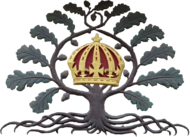 |
In England and Wales, Jacobitism was often associated with theTories,many of whom supported James's right to the throne during theExclusion Crisis.Tory ideology implied that neither "time nor statute law [...] could ameliorate the sin of usurpation",[81]while shared Tory and Jacobite themes of divine right and sacred kingship may have provided an alternative toWhigconcepts of "liberty and property".[82]A minority of academics, includingEveline Cruickshanks,have argued that until the late 1750s the Tories were a crypto-Jacobite party; others, that Jacobitism was a "limb of Toryism".[83]However, the supremacy of the Church of England was also central to Tory ideology, and James lost their support when his policies seemed to threaten that primacy. TheAct of Settlement 1701excluding Catholics from the English throne was passed by a Tory administration; for the vast majority, Stuart Catholicism was an insuperable barrier to active support, while the Tory doctrine of non-resistance also discouraged them from supporting the exiles against a reigning monarch.[84]
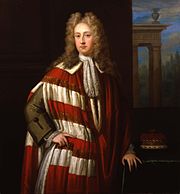
For most of the period from 1690 to 1714, Parliament was either controlled by the Tories, or evenly split with the Whigs; whenGeorge Isucceeded Anne, most hoped to reconcile with the new regime. TheEarl of Mar,who led the 1715 rising, observed "Jacobitisme, which they used to brand the Tories with, is now I presum out of doors".[85]However, George blamed the 1710-to-1714 Tory government for thePeace of Utrecht,which he viewed as damaging to his home state ofHanover.His isolation of former Tory ministers likeLord Bolingbrokeand the Earl of Mar drove them first into opposition, then exile. Their exclusion from power between 1714 and 1742 led many Tories to remain in contact with the Jacobite court, which they saw as a potential tool for changing or pressuring the existing government.[86]
In 1715, there were co-ordinated celebrations on 29 May,Restoration Day,and 10 June, James Stuart's birthday, especially in Tory-dominated towns likeBristol,Oxford,ManchesterandNorwich,although they remained quiet in the 1715 Rising. In the 1730s many 'Jacobite' demonstrations in Wales and elsewhere were driven by local tensions, especially hostility toMethodism,and featured attacks on Nonconformist chapels.[87]Most English participants in 1715 came from traditionally Catholic areas in the northwest, such asLancashire.[88]By 1720 there were fewer than 115,000 in England and Wales, and most remained loyal in 1745, including theDuke of Norfolk,head of the English Catholic community, sentenced to death for his role in 1715 but pardoned.[89]Even so, sympathies were complex; Norfolk's agent Andrew Blood joined theManchester Regiment,and he later employed another ex-officer, John Sanderson, as his master of horse.[90]English Catholics continued to provide the exiles with financial support well into the 1770s.[91]
In 1689, around 2% of clergy in the Church of England refused to take the oath of allegiance to William and Mary; one list identifies a total of 584 clergy, schoolmasters and university dons asNon Jurors.[92]This almost certainly understates their numbers, for many sympathisers remained within the Church of England, but Non Jurors were disproportionately represented in Jacobite risings and riots, and provided many "martyrs". By the late 1720s arguments over doctrine and the death of its originators reduced the church to a handful of scattered congregations, but several of those executed in 1745 came from Manchester, the last significant assembly in England.[93]
QuakerleaderWilliam Pennwas a prominent non-conformist supporter of James, although this was based on their personal relationship and did not survive his deposition. Another element in English Jacobitism was a handful of disaffected radicals, for whom the exiled Stuarts provided a potential alternative to the Whig establishment. An example was John Matthews, a Jacobite printer executed in 1719; his pamphletVox Populi vox Deiemphasised theLockeantheory of thesocial contract,a doctrine very few Tories of the period would have supported.[44]
Scotland
[edit]Scottish Jacobitism had wider and more extensive roots than in England. 20,000 Scots fought for the Jacobites in 1715, compared to 11,000 who joined the government army, and were the majority of the 9,000 to 14,000 who served in 1745.[94]One reason was the persistence of feudalism in parts of rural Scotland, where tenants could be compelled to provide their landlords with military service. Many of the Highlandclansmenwho were a feature of Jacobite armies were raised this way: in all three major risings, the bulk of the rank and file were supplied by a small number of north-western clans whose leaders joined the rebellion.[95]

Despite this, many Jacobites were Protestant Lowlanders, rather than the Catholic, Gaelic-speaking Highlanders of legend.[96]By 1745, fewer than 1% of Scots were Catholic, restricted to the far north-west and a few noble families.[97]The majority of the rank and file, as well as many Jacobite leaders, belonged to Protestant non-juring Episcopalian congregations.[98]Throughout the 17th century, the close connection between Scottish politics and religion meantregime changeswere accompanied by the losers being expelled from theChurch of Scotland.In1690,over 200 clergymen lost their parishes, mostly inAberdeenshireandBanffshire,a strongly Episcopalian area since the 1620s. In 1745, around 25% of Jacobite recruits came from this part of the country.[99]
Episcopalianism was popular among social conservatives, as it emphasised indefeasible hereditary right, absolute obedience, and implied deposition of the senior Stuart line was a breach of natural order.[100]The church continued to offer prayers for the Stuarts until 1788, while many refused to swear allegiance to the Hanoverians in 1714.[101]However, even in 1690, a substantial minority accommodated to the new regime, a number that increased significantly after the establishment of theScottish Episcopal Churchin 1712.[102]
Episcopalian ministers, such as Professor James Garden of Aberdeen, presented the 1707 Union as one in a series of disasters to befall Scotland, provoked by "the sins [...] of rebellion, injustice, oppression, schism and perjury".[103]Opposition was boosted by measures imposed by the post-1707Parliament of Great Britain,including theTreason Act 1708,the 1711 ruling that barred Scots peers with English or British peerages from their seats in theHouse of Lords,and tax increases.[104]Despite their own preferences, the Stuarts tried to appeal to this group; in 1745, Charles issued declarations dissolving the "pretended Union", despite concerns this would alienate his English supporters.[105]
However, opposition to post-Union legislation was not restricted to Jacobites. Many Presbyterians opposed the establishment of the Episcopal Church in 1712 and other measures of indulgence, while the worsttax riotstook place inGlasgow,a town noted for its antipathy to the Stuarts.[106]As in England, some objected less to the Union than the Hanoverian connection;Lord George Murray,a senior Jacobite commander in 1745, was a Unionist who repeatedly disagreed with Charles, but opposed "wars [...] on account of the Electors of Hanover".[107]
Community
[edit]
While Jacobite agents continued in their attempts to recruit the disaffected, the most committed Jacobites were often linked by relatively small family networks, particularly in Scotland; Jacobite activities in areas likePerthshireandAberdeenshirecentred on a limited number of influential families heavily involved in 1715 and 1745.[108]
Some of the most powerful landowning families preserved their establishment loyalties, but maintained traditions of Stuart allegiance by permitting younger sons to become involved in active Jacobitism; in 1745,Lewis Gordonwas widely believed to be a proxy for his brother, theDuke of Gordon.[109]Many Jacobite leaders were closely linked to each other and the exile community by marriage or blood. This has led some historians, notably Bruce Lenman, to characterise the Jacobite risings as French-backedcoupattempts by a small network drawn from the elite, though this view is not universally accepted.[110]
Family traditions of Jacobite sympathy were reinforced through objects such as inscribed glassware or rings with hidden symbols, although many of those that survive are in fact 19th-century neo-Jacobite creations. Other family heirlooms contained reference to executed Jacobite martyrs, for which the movement preserved an unusual level of veneration.[111]Tartancloth, widely adopted by theJacobite armyin 1745, was used in portraiture as a symbol of Stuart sympathies, even before the Rising. Outside elite social circles, the Jacobite community circulated propaganda and symbolic objects through a network of clubs, print-sellers and pedlars, aimed at the provincial gentry and middling sort. In 1745, Prince Charles ordered commemorative medals and miniature pictures for clandestine distribution.[112]
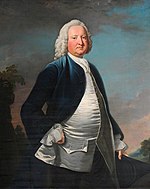
Among the more visible elements of the Jacobite community were drinking clubs established in the early 18th century, such as the Scottish Bucks Club or the "Cycle of the White Rose", led by Welsh TorySir Watkin Williams-Wynn.[113]Others included the "Sea Serjeants", largely composed of South Wales gentry or the "Independent Electors of Westminster" led by theGlamorganshirelawyerDavid Morgan,executed for his role in 1745.[114]Other than Morgan, the vast majority of their members took no part in the 1745 Rising; Charles later said "I will do for the Welsh Jacobites what they did for me. I will drink their health".[115]
Oak Apple Dayon 29 May commemorated Charles II and was an occasion for displays of Stuart sympathy, as was "White Rose Day",the Old Pretender'sbirthday on 10 June.[116]Symbols were commonly employed by Jacobites, given that they could not be prosecuted for their use; the most common of these was theWhite rose of York,adopted after 1688 for reasons now unclear. Various origins have been suggested, including its use as an ancient Scottish royal device, its association with James II asDuke of York,or Charles I being styled as the "White King".[117]Jacobite military units often used plain white standards orcockades,while green ribbons were another recognised Stuart symbol despite their association with the WhigGreen Ribbon Club.[118]
Post-1745 decline
[edit]Despite being greeted as a hero on his return to Paris, Charles' reception behind the scenes was more muted.D’Éguilles,unofficial French envoy to the Jacobites, had a low opinion of him and other senior Jacobites, describing Lochgarry as "a bandit", and suggesting George Murray was a British spy. For their part, the Scots were disillusioned by lack of meaningful English or French support, despite constant assurances of both.[119]Events also highlighted the reality that a low level, ongoing insurgency was far more cost-effective for the French than a restoration, a form of warfare potentially devastating to the local populace.[d]By exposing the divergence between Scottish, French and Stuart objectives, as well as the lack of support in England, the 1745 Rising ended Jacobitism as a viable political alternative in England and Scotland.[44]
The British authorities enacted a series of measures designed to prevent the Scottish Highlands being used for another rising. New forts were built, themilitary roadnetwork finally completed andWilliam Roymade the first comprehensive survey of the Highlands.[120]Much of the power held by the Highland chiefs derived from their ability to require military service from their clansmen and even before 1745 the clan system had been under severe stress due to changing economic conditions; theHeritable Jurisdictions Actremoved such feudal controls by Highland chiefs.[121]This was far more significant than the better-knownAct of Proscriptionwhich outlawed Highland dress unless worn in military service: its impact is debated and the law was repealed in 1782.[121]
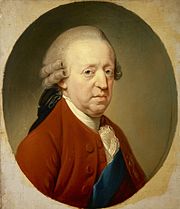
As early as 1745, the French were struggling with the costs of theWar of the Austrian Succession,and in June 1746, they began peace negotiations with Britain atBreda.Victories inFlandersin 1747 and 1748 actually worsened their position by drawing in the previously neutralDutch Republic,whose shipping they relied on to avoid the British naval blockade.[122]By 1748, food shortages among the French population made peace a matter of urgency, but the British refused to sign theTreaty of Aix-la-Chapellewhile Charles remained in France. After he ignored requests to leave, the French lost patience; in December 1748, he was briefly jailed before being deported.[123]
In June 1747, his brotherHenrybecame a Catholic priest; given that Charles had no legitimate heir, this was seen as tacit acceptance by their father James that the Jacobite cause was finished. Charles continued to explore options for a rising in England, including his conversion to Anglicanism, a proposal that had outraged his father James when previously suggested.[124]He "secretly" visited London in 1750 to meet supporters, and was inducted into theNon Juror church.[125]However, the decline of Jacobitism is demonstrated by the fact that KingGeorge IIand his government were well aware of Charles's presence and did nothing to intervene. The English Jacobites made it clear they would do nothing without foreign backing, which despite Charles's overtures toFrederick II of Prussiaseemed unlikely.[126]
A plot to capture or assassinate George II, headed byAlexander Murray of Elibank,was betrayed to the government byAlastair Ruadh MacDonnell,or "Pickle the Spy", but not before Charles had sent two exiles as agents. One wasArchibald Cameron,responsible for recruiting the Cameron regiment in 1745, who was allegedly betrayed by his own clansmen and executed on 7 June 1753.[127]In a 1754 dispute with the English conspirators, a drunken and increasingly desperate Charles threatened to publish their names for having "betrayed" him; most remaining English sympathisers now left the cause.[128]
During theSeven Years' Warin 1759, Charles metChoiseul,thenChief minister of Franceto discussanother invasion,but Choiseul dismissed him as "incapacitated by drink".[129]The Jacobite cause was abandoned by the French, while British supporters stopped providing funds; Charles, who had returned to Catholicism, now relied on the Papacy to fund his lifestyle. However, with the death of Charles's father in 1766, the Hanoverians received the Pope'sde factorecognition.[130]Despite Henry's urgings,Clement XIIIrefused to recognise his brother as Charles III; Charles died of a stroke in Rome in January 1788, a disappointed and embittered man.[131]

Following Charles's death, Scottish Catholics swore allegiance to the House of Hanover, and resolved two years later to pray for King George by name. The Stuart claim passed to Henry, now a Cardinal, who styled himself King Henry IX of England. After he fell into financial difficulty during theFrench Revolution,he was granted a stipend byGeorge III.However, his refusal to renounce his claim to be 'Henry IX' prevented a full reconciliation with the House of Hanover.[132]
During theIrish Rebellion of 1798,headed by theUnited Irishmenwith French support, theDirectorysuggested making HenryKing of the Irish.[133][134]They hoped this would attract support from the Catholic Irish and lead to the creation of a stable pro-French client state.Wolfe Tone,the Protestant republican leader, rejected the suggestion, and a short-livedIrish Republicwas proclaimed instead.[134]
Following the death of Henry in 1807, the Jacobite claim passed to those excluded by the 1701 Act of Settlement. From 1807 to 1840, it was held by theHouse of Savoy,then theHouse of Habsburg-Lorraineuntil 1919, while the current Jacobite heir isFranz, Duke of Bavaria,from theHouse of Wittelsbach.However, neither he nor any of his predecessors since 1807 have pursued their claim. Henry, Charles and James are memorialised in theMonument to the Royal Stuartsin the Vatican.[citation needed]
Analysis
[edit]TraditionalWhig historiographyviewed Jacobitism as a marginal threat to the progression towards present-day Parliamentary democracy, taking the view that as it was defeated, it could never have won.[135]Representing "pre-industrial paternalism" and "mystical loyalism" against forward-thinking individualism, this conception of Jacobitism was reinforced byMacaulay's stereotype of the typical "Tory-Jacobite squire" as a "bigoted, ignorant, drunken philistine".[135]
More recent analyses, such as that ofJ. C. D. Clark,suggest that Jacobitism can instead be regarded as part of a "deep vein of social and political conservatism running throughout British history", arguing that the Whig settlement was not as stable as has been depicted.[136]Further interest in Jacobite studies has been prompted by a reassessment of the nationalist aspirations of Scots Jacobites in particular, emphasising their place as part of an ongoing political debate.
Romantic revival
[edit]As the political danger of Jacobitism receded, the movement was increasingly viewed as a romantic symbol of the past, particularly the final rebellion. Relics and mementoes of 1745 were preserved, and Charles himself celebrated in "increasingly emotional language". This memorialising tendency was reinforced by the publication in the 1830s of selections fromThe Lyon in MourningbyRobert Forbes(1708–1775), a collection of source material and interviews with Jacobite participants in the 1745 rising.[137]
19th-century historiography often presented Scottish Jacobites as primarily driven by a romantic attachment to the Stuarts, rather than the reality of individuals with disparate motives. This suited the Victorian depiction of Highlanders as a "martial race", distinguished by a tradition of a "misplaced loyalism" since transferred to the British crown.[138]The participation of the Lowland Scots and north-eastern gentry was less emphasised, while his Irish Jacobite advisors like CaptainFélix O'Neille y O'Neille,[139]were, until very recently, inaccurately presented as worthless individuals who were solely a negative influence on Charles Stuart in 1745.[140]
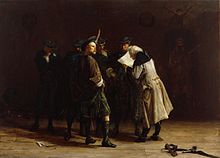
Walter Scott, author ofWaverley,a story of the 1745 rebellion, combined a romantic view of Jacobitism with a belief in what he says as the practical benefits ofWhiggism.In 1822 he arranged a pageantry of reinvented Scottish traditions for thevisit of King George IV to Scotland.The displays oftartanproved immensely popular, and Highland clothing, previously associated with rebellion and regime change, became emblems ofScottish national identity.Some descendants of those attained for rebellion had their titles restored in 1824, while persecutory and discriminatory laws against Catholics wererepealedthrough the efforts ofDaniel O'Connellin 1829. With political and military Jacobitism now safely confined to an "earlier era", the hitherto largely ignored site of their final defeat at Culloden began to be celebrated.[141]
Neo-Jacobite revival
[edit]There was a brief revival of political Jacobitism in the late 1880s and into the 1890s.[142]A number of Jacobite clubs and societies were formed, starting with theOrder of the White Rosefounded byBertram Ashburnhamin 1886.[citation needed]In 1890,Herbert VivianandRuaraidh Erskineco-founded a weekly newspaper,The Whirlwind,that espoused a Jacobite political view.[dead link]Vivian, Erskine andMelville Henry Massueformed theLegitimist Jacobite League of Great Britain and Irelandin 1891, which lasted for several years. Vivian went on to stand for Parliament four times on a Jacobite platform – though he failed to be elected each time.[143]The revival largely came to an end with theFirst World War,and the various societies of the time are now represented by theRoyal Stuart Society.
Literary legacy
[edit]English and Lowland Scots
[edit]Many Jacobite folk songs emerged in Scotland in theRomantic era;a number of examples were collected by Scott's colleagueJames Hoggin hisJacobite Reliques,including several he likely composed himself. Scots poets such asSir Walter Scott,Robert Burns,Alicia Ann Spottiswoode,Agnes Maxwell MacLeod,andCarolina Nairne, Lady Nairne(whose "Bonnie Charlie"remains popular) added further examples. Many of these songs have seen a renewed popularity since the beginning of theBritish folk revivalin the 1950s.
Relatively few of the most famous surviving songs, except for those byWilliam HamiltonandJames Robson,actually date from the time of the risings and the majority of those that do are in other languages than English or Scots.
Irish language literature
[edit]As demonstrated in 1924 byDaniel Corkery,inModern literature in Irish,Jacobitism inspired the enormously influentialAislingordream visiongenre ofIrish bardic poetry.One of the most widely known isMo Ghile MearbySeán Clárach Mac Domhnaill.Other important Jacobite poets who composed immortal verse inMunster Irishduring the 18th-century includedAogán Ó Rathaille,Éamonn an Chnoic,Tadhg Gaelach Ó Súilleabháin,Eoghan Rua Ó Súilleabháin,andDonnchadh Ruadh Mac Conmara.TheAislingpoetic genre has also remained a living tradition and has been adapted, by poets such asMáire Bhuidhe Ní Laoghaire,Pádraig Phiarais Cúndún,andSeán Gaelach Ó Súilleabháinto more recent causes and struggles by theIrish people.Since 1976, an Aisling poem by Liam mac Uistín in honour of "those who gave their lives for Irish freedom" has been permanently displayed at theGarden of RemembranceinDublin.
Scottish Gaelic literature
[edit]By 1933,John Lorne Campbellpublished the groundbreaking bookHighland Songs of the Forty-Five,consisting of 32 Gaelic song-poems, which were analyzed for political content, annotated, and published with facing translations into Englishblank verse,or unrhymediambic pentameter;the real cultural, political, and religious reasons for theJacobite rising of 1745had been obscured by the novels of SirWalter ScottandRobert Louis Stevenson,who both depicted, "the Highlander as aromantic herofighting for a lost cause. "[144]In response, Campbell set out to give, "a voice to the voiceless - ordinary men who had never been allowed to speak for themselves".[145]
As Campbell's volume and his later published writings revealed to theEnglish-speaking world,withinScottish Gaelic literature,Jacobite ideology and the events of the risings inspired the immortal poetry ofIain Lom,Sìleas na Ceapaich,Alasdair Mac Mhaighstir Alasdair,Iain Mac Fhearchair,Catriona Nic Fhearghais,Iain Ruadh Stùibhart,andWilliam Ross.Despite also composing immortal poetry of his own about fighting for the government in theCampbell of Argyll Militiaduring theBattle of Falkirk Muirin 1746,[146]their contemporary,Duncan Ban MacIntyre,offers in his later poetry, according to Campbell, "an interesting testimony to the bitter disillusionment of the Highlanders who had come to the aid of the Government, to be in the end treated no better that those who had rebelled against it."[147]
Claimants to the thrones of England, Scotland, Ireland and France
[edit]- James II and VII(6 February 1685 – 16 September 1701).
- James III and VIII(16 September 1701 – 1 January 1766), James Francis Edward Stuart, also known as theChevalier de St. George,theKing over the Water,or theOld Pretender.(Son of James II)
- Charles III(1 January 1766 – 31 January 1788), Charles Edward Stuart, also known asBonnie Prince Charlie,theYoung Chevalier,or theYoung Pretender.(Son of James III)
- Henry IX and I(31 January 1788 – 13 July 1807), Henry Benedict Stuart, also known as theCardinal King.(Son of James III)
Since Henry's death, none of the Jacobite heirs have claimed the English or Scottish thrones.Franz, Duke of Bavaria(born 1933), a direct descendant ofCharles I,is the current legitimate heir of the house of Stuart. It has been suggested that a repeal of theAct of Settlement 1701could allow him to claim the throne, although he has expressed no interest in doing so.[148]
See also
[edit]- List of movements that dispute the legitimacy of a reigning monarch
- Carlism
- Traditionalist conservatism
Explanatory footnotes
[edit]- ^The "Old Pretender"
- ^The "Young Pretender"
- ^Scottish Gaelic:Seumasachas,[ˈʃeːməs̪əxəs̪];Irish:Seacaibíteachas,Séamusachas;the term derives fromJacobus,theLatinversion of first name ofJames II of England,which is rendered inLatinasJacobusand it followers known asJacobites
- ^Summarised in a British intelligence report of 1755: "...'tis not in the interest of France the House of Stuart shoud ever be restored, as it would only unite the three Kingdoms against Them; England would have no exterior [threat] to mind, and [...] prevent any of its Descendants (the Stuarts) attempting anything against the Libertys or Religion of the People."
Citations
[edit]- ^Harris 2007,pp. 271–272.
- ^Barnes 1973,pp. 310–312.
- ^Gooch 1995,p. 13.
- ^Goldsworthy 2001,pp. 78–79.
- ^Stephen 2010,p. 49.
- ^Ryan 1975,pp. 122–124.
- ^Jacob 1976,pp. 335–341.
- ^Kenyon & Ohlmeyer 1998,p. 12.
- ^Kenyon & Ohlmeyer 1998,p. 16.
- ^Lenihan 2001a,pp. 20–23.
- ^Kenyon & Ohlmeyer 1998,p. 31.
- ^Manganiello 2004,p. 10.
- ^Lenihan 2001b,pp. 11–14.
- ^Lenihan 2014,pp. 140–142.
- ^Worden 2010,pp. 63–68.
- ^Harris 1993b,pp. 581–590.
- ^Miller 1978,pp. 124–125.
- ^McGrath 1996,pp. 27–28.
- ^Harris 1993,pp. 123–127.
- ^Spielvogel 1980,p. 410.
- ^Harris 2007,pp. 235–236.
- ^Harris 2007,pp. 3–5.
- ^Coward 1980,p. 460.
- ^McKay 1983,pp. 138–140.
- ^Lenihan 2014,pp. 174–179.
- ^Lynn 1999,p. 215.
- ^Somerset 2012,pp. 532–535.
- ^"Jacobites and the Union".The Making of the Union.BBC.Archivedfrom the original on 27 June 2020.Retrieved18 August2020.
- ^Ó Ciardha 2000,p. 21.
- ^"The Jacobite Revolts: Chronology".Historic UK.Archivedfrom the original on 23 August 2020.Retrieved18 August2020.
- ^Wills 2001,pp. 57–58.
- ^McLynn 1982,p. 99.
- ^Lenman 1980,p. 36.
- ^McLynn 1982,pp. 98–99.
- ^Szechi 1994,p. 92.
- ^abBrown 2002,p. 47.
- ^Clark 1985,p. 89.
- ^Monod 1993,p. 92.
- ^Monod 1993,p. 18.
- ^Monod 1993,p. 28.
- ^Erskine-Hill 1982,p. 55.
- ^Gibson 2012,p. 12.
- ^McLynn 1982,p. 109.
- ^abcColley 1985,p. 28.
- ^Szechi 1994,p. 38.
- ^Colley 1985,p. 29.
- ^Riding 2016,p. 199.
- ^Monod 1993,p. 81.
- ^Szechi 1994,p. 36.
- ^Szechi 1994,p. 60.
- ^Ó Ciardha 2000,pp. 21, 30.
- ^Connolly 2014,pp. 27–42.
- ^Morely 2016,p. 333.
- ^Connolly 1992,pp. 233–249.
- ^Ó Ciardha 2000,pp. 77–79.
- ^Lenihan 2008,p. 175.
- ^Ó Ciardha 2000,p. 89.
- ^Doyle 1997,pp. 29–30.
- ^Miller 1978,pp. 220–221.
- ^Gillen 2016,p. 52.
- ^Doyle 1997,p. 30.
- ^Lenihan 2008,p. 178.
- ^abcLenihan 2014,p. 136.
- ^Harris 2007,p. 445.
- ^abLenihan 2014,p. 177.
- ^Moody, Martin & Byrne 2009,p. 490.
- ^Simms 1952,pp. 309–312.
- ^Lenihan 2008,p. 183.
- ^abÓ Ciardha 2000,p. 84.
- ^Ó Ciardha 2000,p. 85.
- ^Lenihan 2014,p. 199.
- ^Morley 2007,p. 194.
- ^Lenihan 2014,p. 244.
- ^Garnham 2002,pp. 81–82.
- ^Ó Ciardha 2000,p. 144.
- ^Gillen 2016,p. 59.
- ^Ó Ciardha 2000,p. 374.
- ^Connolly 2003,pp. 64–65.
- ^Graham 2002,p. 51.
- ^Morley 2007,pp. 198–201.
- ^Szechi 1994,p. 64.
- ^Brown 2002,p. 62.
- ^McLynn 1985,p. 81.
- ^McLynn 1982,p. 98.
- ^Colley 1985,p. 26.
- ^McLynn 1982,p. 107.
- ^Rogers 1982,pp. 70–88.
- ^Oates 2016,pp. 97–98.
- ^Yates 2014,pp. 37–38.
- ^Monod 1993,p. 134.
- ^Szechi 1994,pp. 18–19.
- ^Overton 1902,pp. 467–496.
- ^Szechi 1994,p. 19.
- ^Szechi 1994,p. 77.
- ^McCann 1963,p. 20.
- ^Pittock 1998,p. 135.
- ^Hamilton 1963,p. 4.
- ^Szechi 1994,p. 67.
- ^Pittock 1998,p. 99.
- ^Macinnes 2007,p. 235.
- ^Strong 2002,p. 15.
- ^Szechi 1994,pp. 19–20.
- ^Shaw 1999,p. 89.
- ^Szechi 1994,p. 72.
- ^Pittock 1998,p. 26.
- ^Riding 2016,p. 337.
- ^McLynn 1982,pp. 109–110.
- ^Szechi & Sankey 2001,pp. 95–96.
- ^Lenman 1980,p. 255.
- ^Lenman 1980,p. 256.
- ^Szechi 1994,pp. 36–37.
- ^Monod 1993,pp. 81–82.
- ^Lord 2004,p. 40.
- ^Riding 2016,p. 378.
- ^Pittock 1997,p. 107.
- ^Monod 1993,p. 210.
- ^Pittock 1998,pp. 72–73.
- ^Rogers 1982,p. 25.
- ^McLynn 1985,pp. 177–181.
- ^Seymour 1980,pp. 4–9.
- ^abCampsie 2017.
- ^Black 1999,pp. 97–100.
- ^Riding 2016,pp. 496–497.
- ^Corp 2011,p. 334.
- ^Robb 2013.
- ^Pittock 1998,p. 123.
- ^Lenman 1980,p. 27.
- ^Monod 1993,p. 345.
- ^Zimmerman 2003,p. 273.
- ^Hamilton 2015,pp. 57–58.
- ^Pittock 2004.
- ^Johns 1998,p. 161.
- ^Pittock 2006,p. 210.
- ^abAston 2002,p. 222.
- ^abSzechi 1994,p. 5.
- ^Szechi 1994,p. 6.
- ^Pittock 1998,p. 137.
- ^Pittock 2009,p. 143.
- ^Felix O'Neil,Dictionary of Irish Biography
- ^John S. Gibson (1967),Ships of the Forty-Five: The Rescue of the Young Pretender,Hutchinson & Co.London. With aPrefaceby Sir James Fergusson of Kilkerran, Bart., L.L.D. pp. 119-157.
- ^Pittock 2009,p. 146.
- ^Pittock 2014,p.?.
- ^"Stirling Burghs Vacancy".Dundee Evening Telegraph.29 April 1908.
- ^Ray Perman (2013),The Man Who Gave Away His Island: A Life of John Lorne Campbell,Birlinn Limited.Pages 23-26.
- ^Ray Perman (2013),The Man Who Gave Away His Island: A Life of John Lorne Campbell,Birlinn Limited.Page 26.
- ^John Lorne Campbell (1979),Highland Songs of the Forty-Five,Arno Press,New York City. pp. 193-225.
- ^John Lorne Campbell (1979),Highland Songs of the Forty-Five,Arno Press,New York City. pp. 194-195.
- ^Alleyne & de Quetteville 2008.
Sources
[edit]- Alleyne, Richard; de Quetteville, Harry (7 April 2008)."Act repeal could make Franz Herzog von Bayern new King of England and Scotland".The Daily Telegraph.London.Archivedfrom the original on 23 June 2011.Retrieved19 May2011.
- Aston, Nigel (2002).Christianity and Revolutionary Europe, 1750–1830.Cambridge University Press.ISBN978-0521465922.
- Barnes, Robert P. (1973). "James VII's Forfeiture of the Scottish Throne".Albion: A Quarterly Journal Concerned with British Studies.5(4): 299–313.doi:10.2307/4048254.JSTOR4048254.
- Black, Jeremy (1999).From Louis XIV to Napoleon: The Fate of a Great Power.Routledge.ISBN978-1857289343.
- Brown, Richard (2002).Church and State in Modern Britain 1700–1850.Routledge.[ISBN missing]
- John Lorne Campbell(1979),Highland Songs of the Forty-Five,Arno Press,New York City
- Campsie, Alison (31 October 2017)."Myth Buster: Was Tartan Really Banned After Culloden?".The Scotsman.Archivedfrom the original on 21 November 2017.Retrieved7 November2018.
- Chambers, Liam (2018). Binasco, Matteo (ed.).Rome and The Irish Mission at home in Irish Catholicism in the Atlantic World, 1622–1908.Palgrave Press.ISBN978-3319959740.
- Charteris, Evan (1907).A Short Account of the Affairs of Scotland.Edinburgh: David Douglas.
- Clark, J.C.D. (1985).English Society, 1688–1832: Ideology, Social Structure, and Political Practice During the Ancien Regime.Cambridge University Press.ISBN0521309220.
- Colley, Linda (1985).In Defiance of Oligarchy: The Tory Party 1714–60.Cambridge University Press.ISBN978-0521313117.
- Connolly, Sean (1992).Religion, Law and Power: Making of Protestant Ireland, 1660–1760.Clarendon Press.ISBN978-0198201182.
- Connolly, Sean (2014).Patriotism and Nationalism in The Oxford Handbook of Modern Irish History.Oxford University Press.ISBN978-0199549344.
- Connolly, Sean (2003). "Jacobites, Whiteboys and Republicans: Varieties of Disaffection in Eighteenth-Century Ireland".Eighteenth-Century Ireland / Iris an Dá Chultúr.18(1): 63–79.doi:10.3828/eci.2003.7.JSTOR30070994.S2CID164907232.
- Corp, Edward (2011).The Stuarts in Italy, 1719–1766.Cambridge University Press.[ISBN missing]
- Coward, Barry (1980).The Stuart Age 1603–1714.Longman.ISBN978-0582488335.
- Cruikshanks, Lauchlin Alexander (2008).The Act of Union: Death or Reprieve for the Highlands?.Wesleyan University.OCLC705142720.
- Doyle, Thomas (1997). "Jacobitism, Catholicism and the Irish Protestant Elite, 1700–1710".Eighteenth-Century Ireland / Iris an Dá Chultúr.12(1): 28–59.doi:10.3828/eci.1997.4.JSTOR30071383.S2CID256147597.
- Erskine-Hill, H. (1982). "Literature and the Jacobite Cause: Was There a Rhetoric of Jacobitism?". In Cruickshanks, E. (ed.).Ideology and Conspiracy: Aspects of Jacobitism, 1689–1759.Edinburgh: J. Donald.
- Garnham, Neal (2002). Clark, Peter (ed.).Police & Public Order in 18th Century Dublin in Two Capitals: London and Dublin, 1500–1840.British Academy.ISBN978-0197262474.
- Gibson, William (2012).The Church of England 1688–1832: Unity and Accord.Routledge.[ISBN missing]
- Gillen, Ultan (2016).Ascendency Ireland, 1660–1800 in Princeton History of Modern Ireland.Princeton University Press.ISBN978-0691154060.
- Goldsworthy, Jeffrey (2001).The Sovereignty of Parliament: History and Philosophy.Oxford University Press.
- Gooch, Leo (1995).The Desperate Faction?: The Jacobites of North-East England, 1688–1745.University of Hull Press.ISBN978-0859586368.
- Graham, Brian, ed. (2002).In Search of Ireland: A Cultural Geography.Taylor and Francis.ISBN978-1134749188.
- Hamilton, Douglas J. (2015).Jacobitism, Enlightenment and Empire, 1680–1820.Routledge.ISBN978-1317318194.
- Hamilton, Henry (1963).An economic history of Scotland in the Eighteenth century.Clarendon Press.
- Harris, Tim (2007).Revolution; the Great Crisis of the British Monarchy 1685–1720.Penguin.ISBN978-0141016528.
- Harris, Tim (1993).Politics under the Later Stuarts: Party Conflict in a Divided Society, 1660–1715.Longman.ISBN978-0582040823.
- Harris, Tim (1993b). "Party Turns? Or, Whigs and Tories Get Off Scott Free".Albion: A Quarterly Journal Concerned with British Studies.25(4): 581–590.doi:10.2307/4051311.JSTOR4051311.
- Hayes, Richard (1949). "Ireland and Jacobitism".Studies: An Irish Quarterly Review.38(149).
- Jacob, Margaret C. (1976). "Millenarianism and Science in the Late Seventeenth Century".Journal of the History of Ideas.7(32): 335–341.doi:10.2307/2708829.JSTOR2708829.
- James, Francis Godwin (1979). "The Church of Ireland in the Early 18th Century".Historical Magazine of the Protestant Episcopal Church.48(4): 433–451.JSTOR42973720.
- Johns, Christopher M.S. (1998).Antonio Canova and the Politics of Patronage in Revolutionary and Napoleonic Europe.University of California Press.ISBN978-0520212015.
- Kenyon, John; Ohlmeyer, Jane, eds. (1998).The Civil Wars: A Military History of England, Scotland and Ireland, 1638–60.Oxford University Press.ISBN978-0198662228.
- Lenihan, Padraig (2001a).Confederate Catholics at War 1641–1649.Cork University Press.ISBN978-1859182444.
- Lenihan, Padraig (2001b). "Introduction". In Lenihan, Padraig (ed.).Conquest and Resistance: War in Seventeenth-Century Ireland.Brill.ISBN978-9004117433.
- Lenihan, Padraig (2008).Consolidating Conquest: Ireland 1603–1727(2016 ed.). Routledge.ISBN978-1138140639.
- Lenihan, Padraig (2014).The Last Cavalier: Richard Talbot (1631–91).University College Dublin Press.ISBN978-1906359836.
- Lenman, Bruce (1980).The Jacobite Risings in Britain 1689–1746.Methuen Publishing.ISBN978-0413396501.
- Lord, Evelyn (2004).The Stuart Secret Army: The Hidden History of the English Jacobites.Pearson.ISBN978-0582772564.
- Lynn, John (1999).The Wars of Louis XIV, 1667–1714 (Modern Wars in Perspective).Longman.ISBN978-0582056299.
- Macinnes, Allan (2007). "Jacobitism in Scotland: Episodic Cause or National Movement?".Scottish Historical Review.86(222): 225–252.doi:10.3366/shr.2007.86.2.225.S2CID154561509.
- Manganiello, Stephen (2004).The Concise Encyclopedia of the Revolutions and Wars of England, Scotland, and Ireland, 1639–1660.Scarecrow Press.[ISBN missing]
- McCann, Jean E. (1963).The Organisation of the Jacobite Army.PHD thesis Edinburgh University.hdl:1842/9381.OCLC646764870.
- McCormick, Ted (2014).Restoration Ireland, 1660–1688; in The Oxford Handbook of Modern Irish History.Oxford University Press.ISBN978-0198768210.
- McGrath, Charles Ivar (1996). "Securing the Protestant Interest: The Origins and Purpose of the Penal Laws of 1695".Irish Historical Studies.30(117): 25–46.doi:10.1017/S0021121400012566.hdl:10197/9696.JSTOR30008727.S2CID159743855.
- McKay, Derek (1983).The Rise of the Great Powers 1648–1815.Routledge.ISBN978-0582485549.
- McLynn, Frank(1982). "Issues and Motives in the Jacobite Rising of 1745".The Eighteenth Century.23(2): 97–133.JSTOR41467263.
- McLynn, Frank (1985).The Jacobites.Routledge.[ISBN missing]
- Miller, John (1978).James II; A study in kingship.Menthuen.ISBN978-0413652904.
- Mitchell, Albert (1937). "The Non-Jurors; 1688–1805".The Churchman.51(2).
- Monod, Paul (1993).Jacobitism and the English People, 1688–1788.Cambridge University Press.ISBN978-0521447935.
- Moody, Tom; Martin, Frank; Byrne, F.J. (2009).A New History of Ireland: Volume III: Early Modern Ireland 1534–1691.Oxford University Press.ISBN978-0198202424.
- Morley, Vincent (2007). "The Continuity of Disaffection in Eighteenth-Century Ireland".Eighteenth-Century Ireland / Iris an Dá Chultúr.22.
- Morely, Vincent (2016).The Irish Language in Princeton History of Modern Ireland.Princeton University Press.ISBN978-0691154060.
- Ó Ciardha, Eamonn (2000).Ireland and the Jacobite Cause, 1685–1766: A Fatal Attachment.Four Courts Press.ISBN978-1851825349.
- Oates, Jonathan (2016).The Last Battle on English Soil, Preston 1715.Routledge.[ISBN missing]
- Overton, J.H. (1902).The Nonjurors: Their Lives, Principles, and Writings(2018 ed.). Wentworth Press.ISBN978-0530237336.
- Parrish, David (2017).Jacobitism and Anti-Jacobitism in the British Atlantic World, 1688–1727.Royal Historical Society.ISBN978-0861933419.
- Parker, Geoffrey (2002).Empire, War and Faith in Early Modern Europe(2003 ed.). Penguin.ISBN978-0140297898.
- Pittock, Murray(1998).Jacobitism.Palgrave Macmillan.ISBN978-0333667989.
- Pittock, Murray (1997).Inventing and Resisting Britain.Palgrave Macmillan.[ISBN missing]
- Pittock, Murray (2004). "Johnson, Boswell, and their circle". In Keymer, Thomas; Mee, Jon (eds.).The Cambridge companion to English literature from 1740 to 1830.Cambridge: Cambridge University Press. pp. 157–172.ISBN978-0521007573.
- Pittock, Murray (2006).Poetry and Jacobite Politics in Eighteenth-Century Britain and Ireland.Cambridge University Press.ISBN978-0521030274.
- Pittock, Murray (2009).The Myth of the Jacobite Clans: The Jacobite Army in 1745.Edinburgh University Press.ISBN978-0748627561.
- Pittock, Murray (2014).Spectrum of Decadence (Routledge Revivals): The Literature of the 1890s.Routledge.ISBN978-1138799127.
- Plank, Geoffrey (2005).Rebellion and Savagery: The Jacobite Rising of 1745 and the British Empire.University of Pennsylvania Press.ISBN978-0812238983.
- Riding, Jacqueline (2016).Jacobites: A New History of the 45 Rebellion.Bloomsbury.ISBN978-1408819128.
- Robb, Steven (2013). "Gordon, Robert (1703–1779)".Oxford Dictionary of National Biography(online ed.). Oxford University Press.doi:10.1093/ref:odnb/105934.(Subscription orUK public library membershiprequired.)
- Rogers, Nicholas (1998).Crowds, Culture, and Politics in Georgian Britain.Oxford University Press.[ISBN missing]
- Rogers, Nicholas (1982).Riot and Popular Jacobitism in Early Hanoverian England, in Ideology and conspiracy: aspects of Jacobitism, 1689–1759.John Donald Publishers Ltd.ISBN978-0859760843.
- Ryan, Conor (1975). "Religion and State in Seventeenth-Century Ireland".Archivium Hibernicum.33:122–132.doi:10.2307/25487416.JSTOR25487416.
- Seymour, W.A. (1980).A History of the Ordnance Survey.Dawson.ISBN978-0712909792.
- Simms, J.G. (1952). "Williamite Peace Tactics, 1690–1691".Irish Historical Studies.8(32): 303–323.doi:10.1017/S0021121400027528.JSTOR30006194.S2CID164073726.
- Shaw, John S. (1999).The Political History of Eighteenth-Century Scotland.Macmillan.[ISBN missing]
- Smith, Hannah (2013).Georgian Monarchy: Politics and Culture, 1714–60.Cambridge University Press.ISBN978-0521828765.
- Somerset, Anne(2012).Queen Anne; the Politics of Passion.HarperCollins.ISBN978-0007203765.
- Spielvogel, Jackson J (1980).Western Civilization.Wadsworth Publishing.ISBN1285436407.
- Stephen, Jeffrey (January 2010). "Scottish Nationalism and Stuart Unionism".Journal of British Studies.49(1, Scottish Special).doi:10.1086/644534.S2CID144730991.
- Strong, Rowan (2002).Episcopalianism in Nineteenth-Century Scotland: Religious Responses to a Modernizing Society.Oxford University Press.[ISBN missing]
- Szechi, Daniel(1994).The Jacobites: Britain and Europe, 1688–1788(first ed.).Manchester University Press.ISBN978-0719037740.
- Szechi, Daniel; Sankey, Margaret (November 2001). "Elite Culture and the Decline of Scottish Jacobitism 1716–1745".Past & Present(173): 90–128.doi:10.1093/past/173.1.90.JSTOR3600841.
- Wills, Rebecca (2001).The Jacobites and Russia, 1715–1750.Tuckwell Press Ltd.ISBN978-1862321427.
- Worden, Blair (2010). "Oliver Cromwell and the Protectorate".Transactions of the Royal Historical Society.20(6): 57–83.doi:10.1017/S0080440110000058.JSTOR41432386.S2CID159710210.
- Yates, Nigel (2014).Eighteenth Century Britain: Religion and Politics 1714–1815.Routledge.[ISBN missing]
- Zimmerman, Doron (2003).The Jacobite Movement in Scotland and in Exile, 1749–1759.Palgrave Macmillan.ISBN978-1403912916.
External links
[edit]- BBC – Interactive Timeline of British HistoryArchived9 September 2007 at theWayback Machine
- General History of the HighlandsArchived12 May 2019 at theWayback Machine
- The University of Guelph Library, Archival and Special Collections, has more than 500 Jacobite pamphlets, histories, and literature in its rare books section introduced atUG Library: Archival and Special Collections – Jacobite Pamphlets
- Ascanius; or, the Young Adventurer


